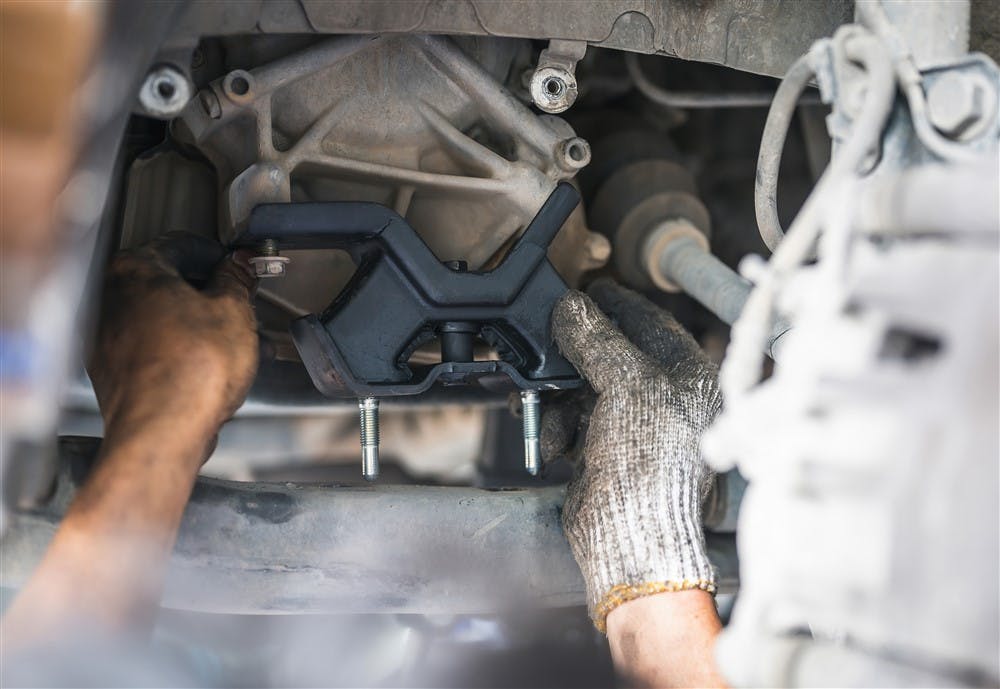Can I Replace my own Engine Mounts?

While it may be possible to replace an engine mount such as the example shown here on a DIY basis if you have the required skills, tools, equipment, and time, we do not recommend that non-professional mechanics attempt the replacement of all engine mounts.
Unlike this example shown here, which is relatively easy to access, some engine mounts are located in places that are almost impossible to reach unless major engine components such as exhaust manifolds/systems, A/C compressors, radiators, and even transmissions are removed from the vehicle to gain access to the affected engine mount.
Moreover, in some cases, it may be necessary to remove all the engine mounts to allow for sufficient movement of the engine/transmission combination to remove a damaged or broken engine mount from the vehicle. In these cases, you need equipment like an engine hoist or a vehicle lift and specialised stands to support the engine during the time the mounts cannot hold it in place.
Note also that installing a replacement engine mount and tightening the engine down again does not always happen in the exact reverse order of removal of the old mount. For instance, replacing some engine mounts on front-wheel drive cars often require the removal of structural components like longitudinal cross-members. Since such components provide strength and rigidity to the vehicle’s structure, removing a cross member can, and usually does, cause the bodywork to “bend” severely unless the vehicle is supported in a very specific way.
In fact, some front-wheel drive vehicles can bend to the point where it may not be possible to refit a cross member until the vehicle is supported at different points to relieve the stresses placed on it by the removal of one or more structural components. Be aware, though, that front-wheel drive vehicles typically do not have sufficiently rigid jacking points forward of the engine to allow for the use of a floor or trolley jack to straighten out the vehicle sufficiently to refit a cross member.
Additionally, even if the vehicle does not bend when a structural component is removed, the engine/transmission combination may rotate around one or more pivot points when some engine mounts are detached from their mounting points. While engine rotations in these circumstances may not always be large, engine/transmission combinations are always heavy and difficult to manipulate back into a position that allows for the fitment of a new engine mount. Indeed, manipulating an engine back into its proper position could require the use of one or more jacks and pry bars of various lengths and configurations to assist in moving the engine around a pivot point to make bolt holes line up sufficiently to insert fasteners into their designated holes.
From the perspective of a professional mechanic, the above situations represent worst-case scenarios that, fortunately, do not always occur during engine mount replacements. However, be aware that even if a given engine mount appears to be reasonably accessible, it could happen that once you begin the process of replacing an easy-to-access mount on a DIY basis, you may discover that other engine mounts that may be greatly more difficult the access, are also damaged and need to be replaced.
As a final thought, it is perhaps worth mentioning that even official repair manuals do not always provide detailed, step-by-step instructions on the best/easiest ways to remove and install engine mounts. Thus, unless you know the vehicle you are going to be working on very well and have the required skills and equipment to replace an engine mount, you could be working “blind” in the sense that you have no guidance on what to do first.
Put differently, this means that if you have never replaced an engine mount that is difficult to access and remove, you will have no information upon which to plan the job in such a way that you do not cause (possibly fatal) damage to one or more engine components.
So, all things considered, it is certainly possible to replace engine mounts on A DIY basis, provided you bear in mind that these procedures can not only be extremely difficult and challenging but also that the likelihood of damaging engine components as well as sustaining serious personal injuries is extremely high.
